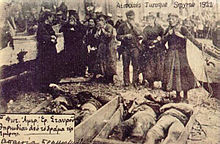Greek genocide
1913–1922 genocide of Greek Christians in the Ottoman Empire / From Wikipedia, the free encyclopedia
Dear Wikiwand AI, let's keep it short by simply answering these key questions:
Can you list the top facts and stats about Greek genocide?
Summarize this article for a 10 years old
The Greek genocide[4][5][6][7][A 1] (Greek: Γενοκτονία των Ελλήνων, Genoktonia ton Ellinon), which included the Pontic genocide, was the systematic killing of the Christian Ottoman Greek population of Anatolia which was carried out mainly during World War I and its aftermath (1914–1922) on the basis of their religion and ethnicity.[13] It was perpetrated by the government of the Ottoman Empire led by the Three Pashas and by the Government of the Grand National Assembly led by Mustafa Kemal Atatürk,[1] against the indigenous Greek population of the Empire. The genocide included massacres, forced deportations involving death marches through the Syrian Desert,[14] expulsions, summary executions, and the destruction of Eastern Orthodox cultural, historical, and religious monuments.[15] Several hundred thousand Ottoman Greeks died during this period.[16] Most of the refugees and survivors fled to Greece (adding over a quarter to the prior population of Greece).[17] Some, especially those in Eastern provinces, took refuge in the neighbouring Russian Empire.
| Greek genocide | |
|---|---|
| Part of World War I, the aftermath of World War I and the late Ottoman genocides | |
 Greek civilians mourn their dead relatives, Great Fire of Smyrna, 1922 | |
| Location | Ottoman Empire |
| Date | 1913–1923[1] |
| Target | Greek population, particularly from Pontus, Cappadocia, Ionia and Eastern Thrace |
Attack type | Deportation, genocide, death marches, others |
| Deaths | 300,000–900,000[2][3] (see casualties section below) |
| Perpetrators | Ottoman Empire, Turkish National Movement |
| Trials | Ottoman Special Military Tribunal |
| Motive | Anti-Greek sentiment, Turkification, Anti-Eastern Orthodox sentiment |
| Part of a series on |
| Genocide |
|---|
 |
| Issues |
| 18th /19th/early 20th century genocides |
| Late Ottoman genocides (1910s–1920s) |
| World War II (1939–1945) |
| Cold War (1940s–1991) |
| Contemporary ethno-religious genocides |
| Related topics |
|
| Category |
By late 1922, most of the Greeks of Asia Minor had either fled or had been killed.[18] Those remaining were transferred to Greece under the terms of the later 1923 population exchange between Greece and Turkey, which formalized the exodus and barred the return of the refugees. Other ethnic groups were similarly attacked by the Ottoman Empire during this period, including Assyrians and Armenians, and some scholars and organizations have recognized these events as part of the same genocidal policy.[19][7][20][6][21]
The Allies of World War I condemned the Ottoman government–sponsored massacres. In 2007, the International Association of Genocide Scholars passed a resolution recognising the Ottoman campaign against its Christian minorities, including the Greeks, as genocide.[7] Some other organisations have also passed resolutions recognising the Ottoman campaign against these Christian minorities as genocide, as have the national legislatures of Greece,[22][23][5] Cyprus,[24] the United States,[25][26][27][28] Sweden,[29][30] Armenia,[31] the Netherlands,[32][33] Germany,[34][35] Austria[36][37] and the Czech Republic.[38][39][40]